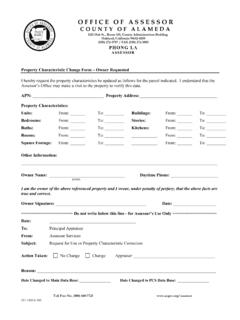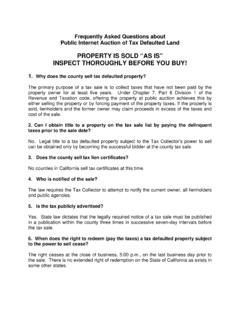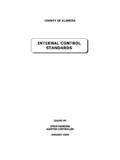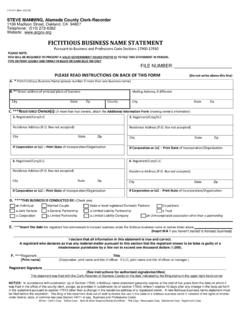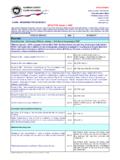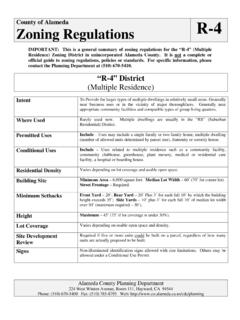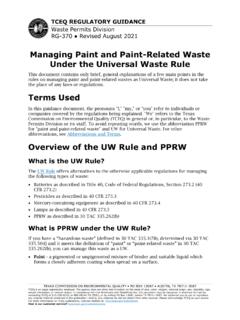Transcription of EPA Identification Numbers - Alameda County, California
1 Regulatory Assistance Officer s Notes: The Department of Toxic Substances Control (DTSC) prepared this fact sheet to provide general information about EPA Identification Numbers . Throughout the online version of this fact sheet, Numbers in blue ( ) represent citations from the California Code of Regulations or the California Health and Safety Code. Click-ing on the blue Numbers will take you to sites containing the regulations. If you generate hazardous waste , you should consult with your Certified Unified Program Agency (CUPA). Finally, DTSC strongly encourages all businesses that generate hazardous waste to consider waste minimization, source reduction, and pollution prevention. What is an EPA ID Number? This number, issued either by the U. S. Environmental Protection Agency ( EPA ID Number), or by DTSC ( California ID Number), identifies each handler of haz-ardous waste on hazardous waste manifests and other paperwork. The ID Number enables regulators to track the waste from its origin to final disposal ( cradle to grave.)
2 With the exceptions discussed later in this guidance, most hazardous waste generators must have an ID Number before a registered hazardous waste transporter will accept the waste for shipment. All hazardous waste transporters and permitted treatment, storage and disposal facilities must have ID Numbers . Are State and Federal laws the same? The federal hazardous waste law (the Resource Conservation and Recovery Act, or RCRA ) allows states to enact their own hazardous waste laws, which must be at least as stringent as the federal laws. The requirements under California law are more stringent than the federal criteria. Wastes that pass the federal hazardous waste criteria but fail the California criteria are called non-RCRA or California -only hazardous wastes. Wastes containing corrosive solids, asbestos, nickel or zinc are examples of common California -only hazardous wastes. Other states may not con-sider California -only wastes hazardous.
3 Federal law also exempts generators of small quantities of waste from many federal waste management requirements. Fact Sheet, January 2006 EPA Identification Numbers How many ID Numbers do I need? ID Numbers are site-specific and there is nor-mally only one number at a business address. If you have a business that generates waste at mul-tiple addresses that are not physically connected (contiguous), each address needs a separate ID Number. In the case where generators are inde-pendent businesses that operate in suites within the same building, each business must have their own ID Number. If you are not clear as to whether you operate on one site or multiple sites, contact your local environmental agency or the DTSC information resources listed at the end of this fact sheet. Do I need a EPA ID Number, or a California ID Number? If you generate more than 1 kilogram of RCRA acutely hazardous waste per month or more than 100 kilograms of other RCRA waste per month, you must get a EPA ID Number.
4 If you generate 100 kilograms or less of RCRA waste or one kilogram or less per month of acutely haz-ardous waste , and meet certain other require-ments, you are exempted by EPA from many of its regulations, including the require-ment to have an EPA ID Number. These busi-nesses are called conditionally exempt small-quantity generators , or CESQGs. The regula-tory citation is 40 CFR section However, California regulations do not have an equivalent small quantity generator exemption. Almost all business generators of hazardous waste in California that are not required to have a EPA ID Number must, in practice, have a California ID Number. See California Code of Regulations title 22, section How-ever: 1. Generators handling only hazardous waste produced incidental to owning and maintaining their own place of residence do not need an ID Number, either federal or state. 2. Businesses whose ONLY hazardous waste generation is 100 kilograms or less per month of waste that is hazardous solely because of its sil-ver content ( silver-only waste ) do not need an ID Number.
5 This is true even if they treat the waste in silver-recovery units and then send the silver for reclamation. See Health and Safety Code section Also see the DTSC Fact Sheet, Onsite Tiered Permitting: Changes in Regulation of Silver Wastes. 3. Businesses that generate ONLY universal waste (fluorescent lamps, batteries, mercury wastes, etc.) and manage it as such also do not need an ID Number. For information about Uni-versal waste , here is a link to DTSC s Managing Universal waste in California . In summary, except for the above-mentioned ex-emptions, if you generate only non-RCRA haz-ardous wastes, or you generate less than 100 kilograms of RCRA hazardous waste per month (or less than 1 kilogram of RCRA acutely haz-ardous waste ), you must get a California ID Number. If you generate more than 100 kilo-grams of RCRA waste per month or more than 1 kilogram of RCRA acutely hazardous waste per month, then you must get a EPA ID Num-ber. I used to be exempt from ID Number requirements.
6 What happened? The passage of Senate Bill 271 (effective January 1, 2002) removed the exemption that once al-lowed small generators of used oil and solvents to offer waste for transport without an EPA ID Number (former milkrun or modified manifest procedures.) The Consolidated Manifesting procedure that re-placed the milkrun manifesting procedure re-quires that generators using consolidated transporters provide them with an ID Number. 2 How do I get an EPA ID Number? Handlers of RCRA waste who need an EPA ID Number must send a Notification of Regu-lated waste Activity , form 8700-12, to the EPA contractor at the address given in its in-structions. You can request this form by calling (415) 495-8895, or you can download the form from the EPA web site. Handlers who do not need a EPA ID but do need a California ID Number can obtain it by completing and submitting the California Haz-ardous waste Permanent ID Number Applica-tion , DTSC Form 1358, by mail, email, or fax.
7 You can download the form from the DTSC website or you can request a blank form by call-ing DTSC at 800-618-6942. DTSC no longer is-sues permanent ID Numbers by telephone. Am I charged fees for the issuance of the ID Number? There is no charge for issuing the number, but DTSC is required to collect an annual business information verification fee for each permanent ID Number. The fee is based on the number of employees in the entire organization. If your business has fewer than 50 employees, the fee is zero. There is no verification fee for a Tempo-rary ID Number. Frequently Asked Questions about the ID Number verification process and manifest fees are available on the DTSC website. I usually don t generate hazardous waste , but I recently generated some. Can I get a temporary EPA ID Number for this one time event? DTSC issues temporary (or provisional ) ID Numbers to people or businesses that do not rou-tinely generate hazardous waste .
8 Examples of non-routine activities include asbestos abate-ment, removing underground tanks, and remov-ing hazardous wastes that were abandoned in a leased building. A California temporary number is only valid for non-RCRA ( California only) waste or when the total RCRA waste hauled is less than 220 pounds or 27 gallons per month. To get a California temporary ID Number, call DTSC at (800) 618-6942 (in-state) or (916) 255-1136 (out-of-state.) EPA also issues provi-sional ID Numbers for non-routinely generated federal wastes. Temporary and provisional ID Numbers are valid for a maximum of 90 days but can be used to haul any amount of hazardous waste that has been generated at the site before and during that period. Holders of temporary Numbers are not charged EPA ID verification fees. Do I need to get a new ID Number if I move my business? Yes. If you have a California ID Number, submit one DTSC Form 1358 to deactivate your old number, and another to request that a number be issued for your new location.
9 This is also true if you are selling or buying a business; the seller must inactivate the old number and have the new owner submit a DTSC Form 1358 to have a new number issued. If you have a EPA ID Number, these actions are done through the use of Form 8700-12, Notification of Regulated waste Activity". I've always wondered: do the letters in front of the ID Numbers mean anything? Early federally issued ID Numbers had two let-ters corresponding to the generator s state and ten digits. Current ID Numbers consist of three letters followed by nine digits. The significance of those letters is as follows: 3 EPA ID Numbers CAR Federal permanent number currently be-ing issued. CA Federal permanent number that preceded the CAR prefix. ID Numbers with a CA prefix are still valid, but have not been is-sued since February 1995. CAD Federal permanent number that preceded the CA prefix, or a State permanent or provisional number issued before 1988.
10 ID Numbers with a CAD prefix have not been issued since August 1993. CAT Federal permanent number that preceded the CAD prefix. CAP Federal provisional or emergency number currently issued. California ID Numbers CAL State permanent number. CAC State provisional or emergency number. CAH State provisional or permanent number issued for Household Hazardous waste Collections. CAI State permanent number issued for Ex-otic Pest Detection. CAE State provisional number issued for re-moval of hazardous waste caused by a natural disaster. CAF State permanent number issued for farm used oil. CAS State permanent number issued for Emergency Response. CLU Clandestine Drug Lab cleanup. CAX State permanent or provisional number issued before 1987. A CAX number is no longer a valid ID number. CA99 State permanent number issued to cruise ships. DTSC Regulatory Assistance Officers provide informal guidance regarding management of hazardous waste for the convenience of the pub-lic.
